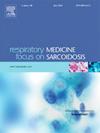Pulse corticosteroid therapy in interstitial lung disease-associated with anti-aminoacyl-tRNA synthetase antibodies: Comparable efficacy with potential for reduced adverse events
IF 3.5
3区 医学
Q2 CARDIAC & CARDIOVASCULAR SYSTEMS
引用次数: 0
Abstract
Background and objective
The optimal treatment modality for interstitial lung disease (ILD) associated with anti-aminoacyl-tRNA synthetase (ARS) antibodies remains controversial. This study aimed to compare the efficacy and safety of pulse corticosteroid therapy with that of conventional corticosteroid therapy in patients with anti-ARS ILD.
Methods
This retrospective cohort study included 62 patients with anti-ARS ILD. Patients were divided into two groups: Those who received pulse corticosteroid therapy (500–1000 mg of methylprednisolone intravenously for three days) and those who received conventional corticosteroid therapy. Primary outcomes included initial treatment response at one year and disease recurrence. Secondary outcomes were alterations in pulmonary function tests, KL-6 levels, prednisolone dose, and adverse events.
Results
Both the pulse corticosteroid therapy group and the conventional therapy group had similar rates of initial treatment improvement (90.3 % vs. 77.4 %, p = 0.301), with no significant differences in recurrence-free survival. Improvements in pulmonary function tests were comparable between the two groups. At 12 months, the mean daily prednisolone dose was 3.9 mg in the pulse therapy group compared with 6.0 mg in the conventional therapy group. The pulse corticosteroid therapy group also experienced fewer adverse events (25.8 % vs. 61.3 %, p = 0.010).
Conclusion
Pulse corticosteroid therapy provides similar treatment efficacy, earlier reduction in corticosteroid dosage, and a lower incidence of adverse events compared to conventional therapy in patients with anti-ARS ILD. These findings highlight the potential benefit of a steroid-sparing strategy, suggesting that pulse corticosteroid therapy may be considered an effective and safer option in managing this condition.
求助全文
约1分钟内获得全文
求助全文
来源期刊

Respiratory medicine
医学-呼吸系统
CiteScore
7.50
自引率
0.00%
发文量
199
审稿时长
38 days
期刊介绍:
Respiratory Medicine is an internationally-renowned journal devoted to the rapid publication of clinically-relevant respiratory medicine research. It combines cutting-edge original research with state-of-the-art reviews dealing with all aspects of respiratory diseases and therapeutic interventions. Topics include adult and paediatric medicine, epidemiology, immunology and cell biology, physiology, occupational disorders, and the role of allergens and pollutants.
Respiratory Medicine is increasingly the journal of choice for publication of phased trial work, commenting on effectiveness, dosage and methods of action.
 求助内容:
求助内容: 应助结果提醒方式:
应助结果提醒方式:


